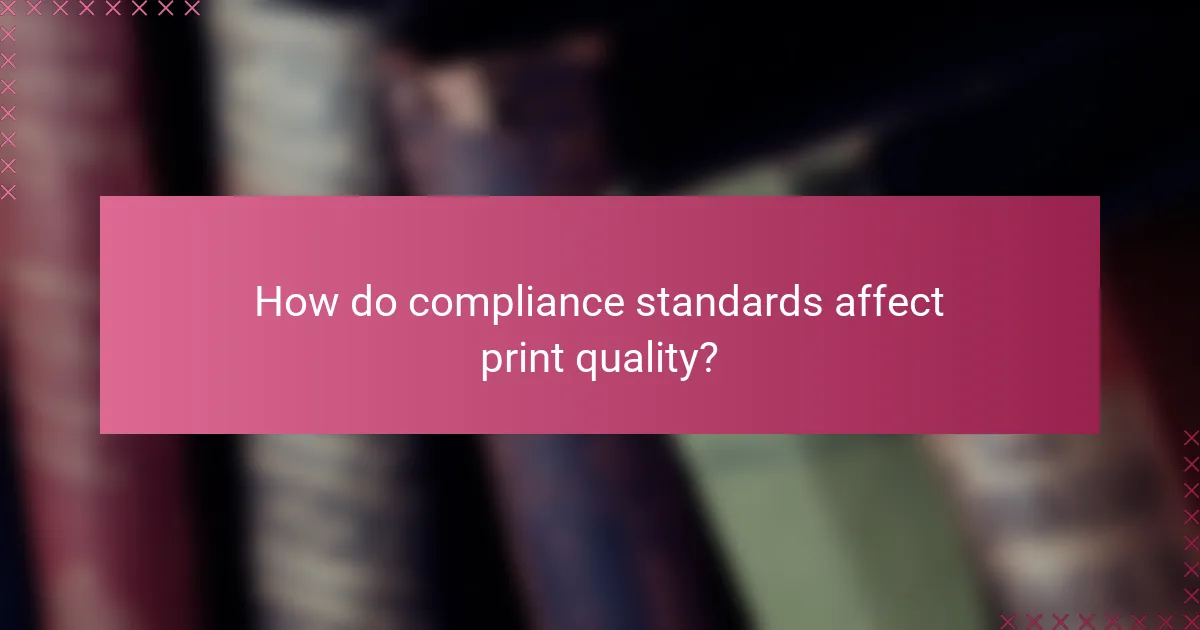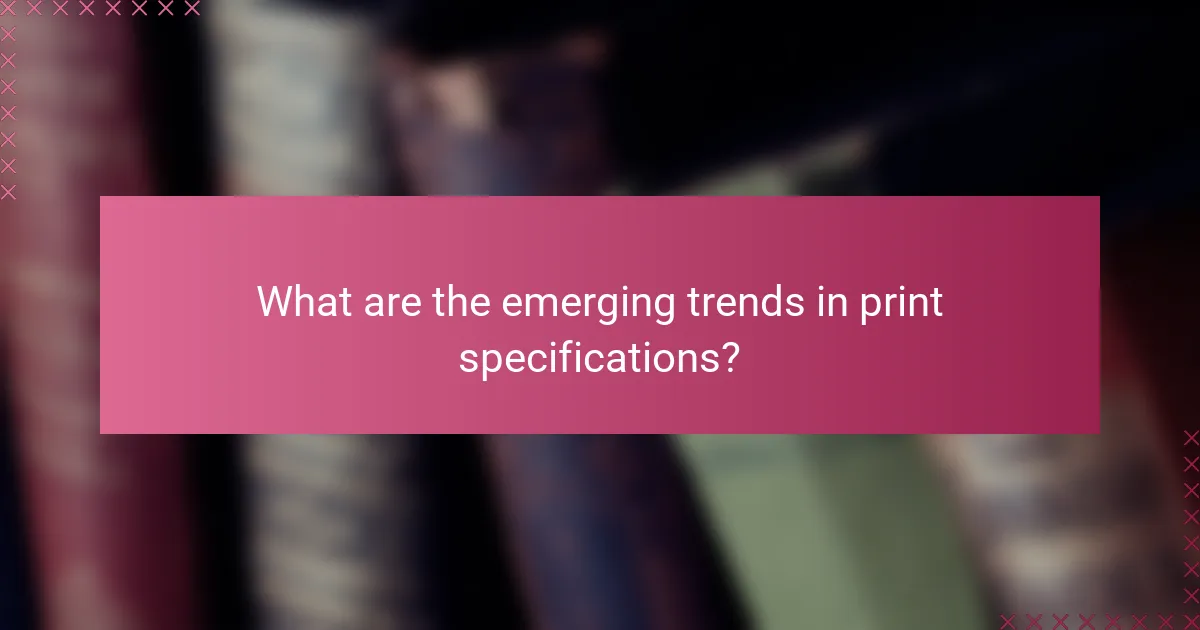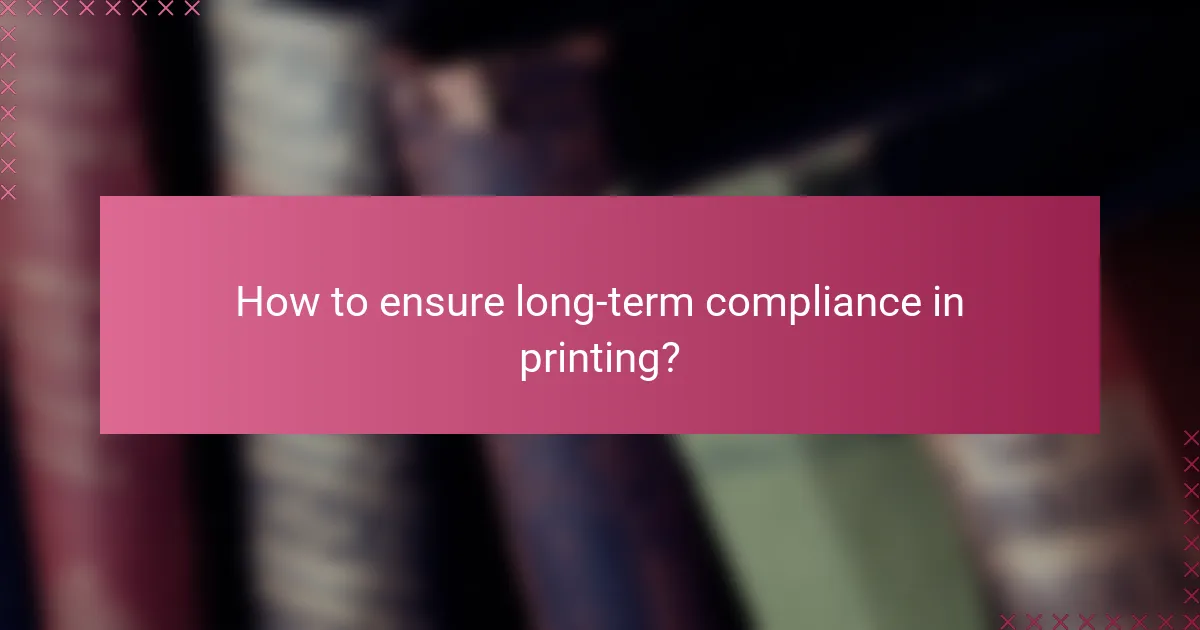Understanding print specifications is vital for achieving high-quality printed materials that adhere to professional standards. Key factors such as resolution, color accuracy, and paper types play a significant role in determining print quality. Compliance with established standards not only ensures safety and performance but also enhances customer satisfaction. By prioritizing meticulous preparation and rigorous quality control, businesses can achieve print success and meet their project goals effectively.

What are the key print specifications for quality standards?
The key print specifications for quality standards include resolution, color accuracy, paper types, finishing options, and compatibility with print technology. Understanding these factors is essential for achieving high-quality printed materials that meet professional standards.
Resolution and DPI requirements
Resolution, measured in dots per inch (DPI), is crucial for print quality. A higher DPI typically results in sharper images and finer details; for example, 300 DPI is standard for high-quality prints, while 150 DPI may suffice for less critical applications.
When preparing images for print, ensure they meet the required DPI specifications. Low-resolution images can appear pixelated or blurry when printed, so always check the source material before finalizing your design.
Color accuracy and calibration
Color accuracy is vital for ensuring that printed materials reflect the intended colors. This involves calibrating monitors and printers to maintain consistency across devices. Using color profiles, such as CMYK for print, helps achieve the desired results.
Regularly calibrate your equipment and conduct test prints to verify color accuracy. Be aware that different paper types can affect color reproduction, so consider the final medium when selecting colors.
Paper types and weights
Choosing the right paper type and weight is essential for print quality and durability. Common paper weights range from 70 to 300 grams per square meter (gsm), with heavier papers providing a more premium feel.
Consider the purpose of your print project when selecting paper. For instance, glossy paper works well for vibrant images, while matte paper is better for text-heavy documents. Always request samples to evaluate how different papers perform with your design.
Finishing options and techniques
Finishing options enhance the appearance and durability of printed materials. Common techniques include lamination, embossing, and foil stamping, each offering unique visual and tactile effects.
When selecting finishing options, consider the target audience and the intended use of the printed piece. For example, a business brochure may benefit from a professional matte finish, while a promotional flyer might look more eye-catching with a glossy finish.
Print technology compatibility
Different print technologies, such as digital, offset, and screen printing, have specific requirements and limitations. Understanding these can help you choose the right method for your project based on volume, cost, and quality needs.
Always verify that your design files are compatible with the chosen print technology. For example, certain color modes or file formats may not be suitable for all printers, so consult with your print provider to ensure a smooth production process.

How do compliance standards affect print quality?
Compliance standards play a crucial role in determining print quality by ensuring that products meet specific benchmarks for performance and safety. Adhering to these standards helps businesses avoid costly errors and enhances customer satisfaction through consistent quality.
ISO standards for printing
ISO standards, such as ISO 12647, set the framework for color management and print quality control in the printing industry. These standards provide guidelines for various processes, including prepress, printing, and finishing, ensuring that the final product meets customer expectations and regulatory requirements.
Implementing ISO standards can lead to improved consistency and reduced waste in the printing process. Companies that achieve ISO certification often enjoy a competitive edge, as clients tend to prefer suppliers who demonstrate a commitment to quality and compliance.
Environmental compliance regulations
Environmental compliance regulations, such as the EU’s REACH and RoHS directives, require printing companies to minimize their environmental impact by controlling hazardous substances and managing waste. Compliance with these regulations not only protects the environment but also enhances the company’s reputation among eco-conscious consumers.
To meet these regulations, printers should adopt sustainable practices, such as using eco-friendly inks and materials, and implementing waste reduction strategies. Regular audits and staff training can help ensure ongoing compliance and improve overall print quality.
Industry-specific compliance requirements
Different industries have unique compliance requirements that can affect print quality. For example, the pharmaceutical industry mandates strict labeling and packaging standards to ensure safety and traceability. Similarly, food packaging must adhere to regulations regarding material safety and hygiene.
Understanding and integrating these industry-specific requirements into the printing process is essential for maintaining quality. Companies should stay informed about relevant regulations and invest in training and resources to ensure compliance, ultimately leading to better products and customer trust.

What are the best practices for achieving print success?
To achieve print success, focus on meticulous preparation, rigorous quality control, and careful vendor selection. These practices ensure that the final product meets quality standards and aligns with project goals.
Pre-press preparation steps
Effective pre-press preparation is crucial for print success. Start by ensuring that all files are correctly formatted, including resolution, color profiles, and bleed specifications. Common formats like PDF are preferred for their compatibility and reliability.
Next, conduct a thorough proofing process. This includes both digital proofs and physical samples to catch any errors before the final print run. Engaging stakeholders in this stage can help identify potential issues early on.
Quality control measures
Implementing quality control measures throughout the printing process is essential. This includes regular checks at various stages, such as pre-press, during printing, and post-production. Use tools like color calibration devices to ensure color accuracy.
Establish clear benchmarks for quality, such as acceptable levels of color variation and print defects. Documenting these standards helps maintain consistency and provides a reference for future projects.
Vendor selection criteria
Selecting the right vendor is vital for achieving print success. Consider factors such as the vendor’s experience, reputation, and the quality of their previous work. Request samples to evaluate their print quality firsthand.
Additionally, assess their capabilities in terms of technology and materials. A vendor that uses state-of-the-art equipment and offers a variety of paper options can better meet your specific needs. Communication and responsiveness are also key traits to look for in a reliable partner.

How to choose the right printing service?
Choosing the right printing service involves assessing the provider’s capabilities, pricing models, and customer feedback. Focus on quality, reliability, and value to ensure your printing needs are met effectively.
Evaluating service provider capabilities
Start by examining the printing technologies and equipment a service provider uses. Look for modern machinery that can handle various materials and finishes, as this often correlates with higher quality outputs.
Additionally, consider the range of services offered. Some providers specialize in specific areas, such as digital printing or large format, while others may offer a broader spectrum including design and fulfillment services. This can impact your overall project efficiency.
Comparing pricing models
Pricing models can vary significantly among printing services. Some may charge per unit, while others might offer bulk pricing or flat rates for specific projects. Understanding these models can help you budget effectively.
Request quotes from multiple providers to compare costs. Be aware of hidden fees, such as setup charges or shipping costs, which can affect the total price. A clear breakdown of costs will help you make an informed decision.
Assessing customer reviews and testimonials
Customer reviews are a valuable resource for gauging a printing service’s reliability and quality. Look for feedback on platforms like Google Reviews or industry-specific sites to get a well-rounded view of their performance.
Pay attention to comments regarding turnaround times, customer service, and print quality. Consistent positive feedback in these areas is a strong indicator of a trustworthy provider. Additionally, consider reaching out to past clients for direct testimonials if possible.

What are the emerging trends in print specifications?
Emerging trends in print specifications focus on sustainability, technological advancements, and automation. These trends are reshaping the industry by enhancing efficiency, reducing environmental impact, and improving overall print quality.
Sustainable printing practices
Sustainable printing practices are becoming essential as businesses seek to minimize their environmental footprint. This includes using eco-friendly inks, recycled materials, and energy-efficient processes. Companies are increasingly adopting certifications like FSC (Forest Stewardship Council) to ensure responsible sourcing.
To implement sustainable practices, consider using digital proofs instead of physical ones to reduce waste. Additionally, evaluate suppliers based on their sustainability efforts, as this can significantly impact your overall environmental impact.
Advancements in digital printing technology
Advancements in digital printing technology are revolutionizing the industry by offering faster turnaround times and greater customization. Technologies such as inkjet and laser printing have improved significantly, allowing for high-quality prints at lower costs. This shift enables businesses to produce short runs economically.
When choosing digital printing solutions, assess the capabilities of the equipment, including color accuracy and material compatibility. Staying updated with the latest technology can help you meet customer demands more effectively and enhance your competitive edge.
Integration of automation in print processes
Integration of automation in print processes streamlines production and reduces human error. Automated workflows can manage tasks such as pre-press, printing, and post-press, leading to increased efficiency and consistency. This trend is particularly beneficial for high-volume printing operations.
To leverage automation, invest in software that integrates with your existing systems, allowing for seamless data transfer and task management. Regularly review your processes to identify areas where automation can save time and resources, ultimately improving your operational efficiency.

How to ensure long-term compliance in printing?
Ensuring long-term compliance in printing involves implementing consistent quality standards and regular evaluations. This proactive approach helps maintain adherence to industry regulations and enhances product reliability.
Regular audits and assessments
Conducting regular audits and assessments is crucial for maintaining compliance in printing. These evaluations should focus on processes, materials, and finished products to identify any deviations from established standards.
Consider scheduling audits quarterly or biannually, depending on production volume and complexity. Utilize checklists that cover key compliance areas such as material safety, equipment calibration, and environmental regulations.
Common pitfalls include neglecting to document findings or failing to follow up on corrective actions. Ensure that all audit results are recorded and that action plans are developed to address any identified issues promptly.
